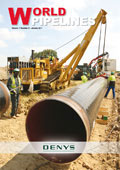Editorial comment
Late last year, in what one official called an “early Christmas present” to Canada, the National Energy Board (NEB) gave its stamp of approval to the proposed Cdn$ 16.2 billion Mackenzie Valley natural gas pipeline.
Register for free »
Get started now for absolutely FREE, no credit card required.
This is an important step for the pipeline’s backers, but it doesn’t mean that we’re going to see ground being broken in 2011. The approval does come with certain conditions, however, one of which being that Imperial Oil must decide before 2013 whether or not it will build the line. Construction must start by the end of 2015 for the approval to remain valid – and this sets a tight timeframe for the project, which has already taken 30 years to come this far!
Imperial leads the Mackenzie project, working in a consortium with Shell Canada, ConocoPhillips Canada, ExxonMobil and the Aboriginal Pipeline Group, whose stake is funded by TransCanada. If realised, the 1196 km pipeline would bring gas from the fields in the sub-Arctic Mackenzie Delta in Canada’s Northwest Territories, along the Mackenzie Valley to connect with North American markets. Developing its Arctic reserves could mean Canada could ship up to 1.2 billion ft3/d through the pipeline. Three major fields in the Mackenzie Delta are believed to hold 6 trillion ft3 of natural gas, and sit awaiting development.
Now that the project has completed the regulatory process, it faces many other challenges as it advances, including environmental opposition, permitting authorisations, investment wrangling and the harsh realities of planning pipeline construction for permafrost regions. It also faces competition from the current excess of gas in the US and subsequent low gas prices. The greatest contributing factor to whether the pipeline gets built is funding. The consortium has already spent hundreds of millions of dollars developing the project but will need further federal support.
Imperial spokesman Pius Rolheiser has said that the NEB deadlines “will be challenging…dependant on how long it takes to reach agreement with the federal government on fiscal terms”. Ottawa has yet to sign an agreement that would provide monetary support to the project.
So, with a sunset clause on construction set in place for 31st December 2015, the question remains what kind of financial package the project will receive from the federal government. It is well-publicised that the project would bring many benefits for the communities of the north, including an estimated Cdn$ 67.5 billion over the lifespan of the pipeline, along with over 200 000 man hours’ worth of employment.
But has the sun already gone down on this one? First proposed in the late 1970s, this pipeline has been on the table for so long and the world has changed. As Gary Leach, President of the Small Explorers and Producers Association of Canada said, the approval is “anticlimactic”. He argues that the Mackenzie project “is the poster child for a regulatory process that takes too long”.
Now it is finally approved, the US gas market is flooded with a 100 year supply of gas and some might say that the timing is all wrong.


